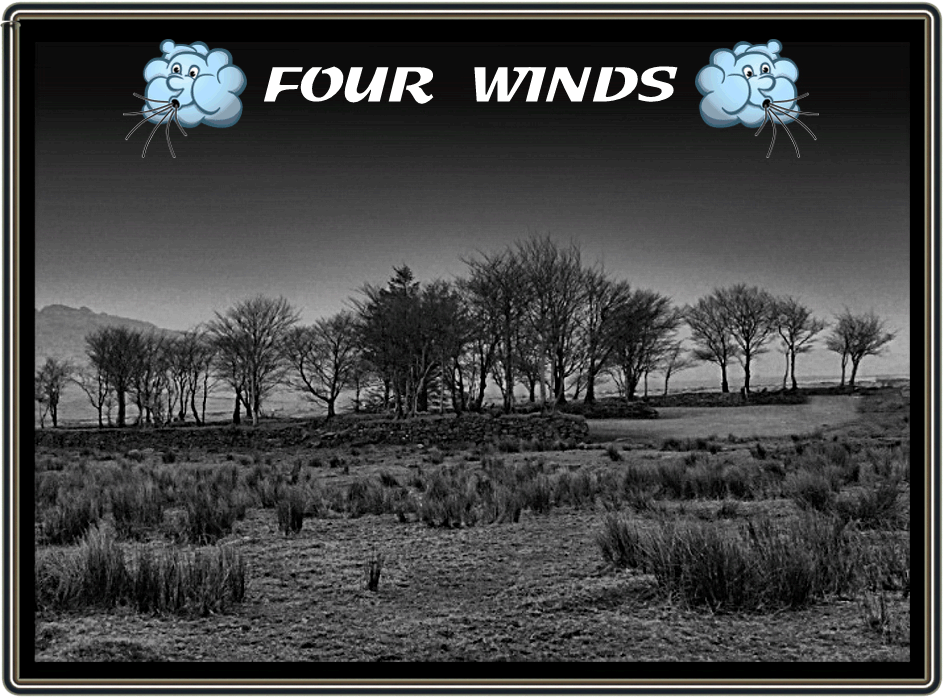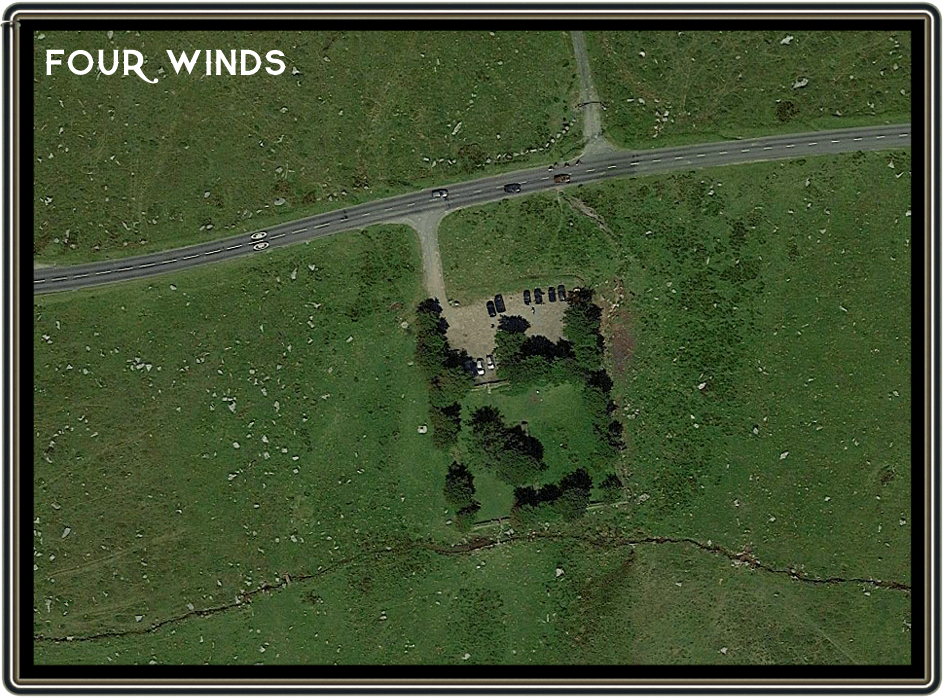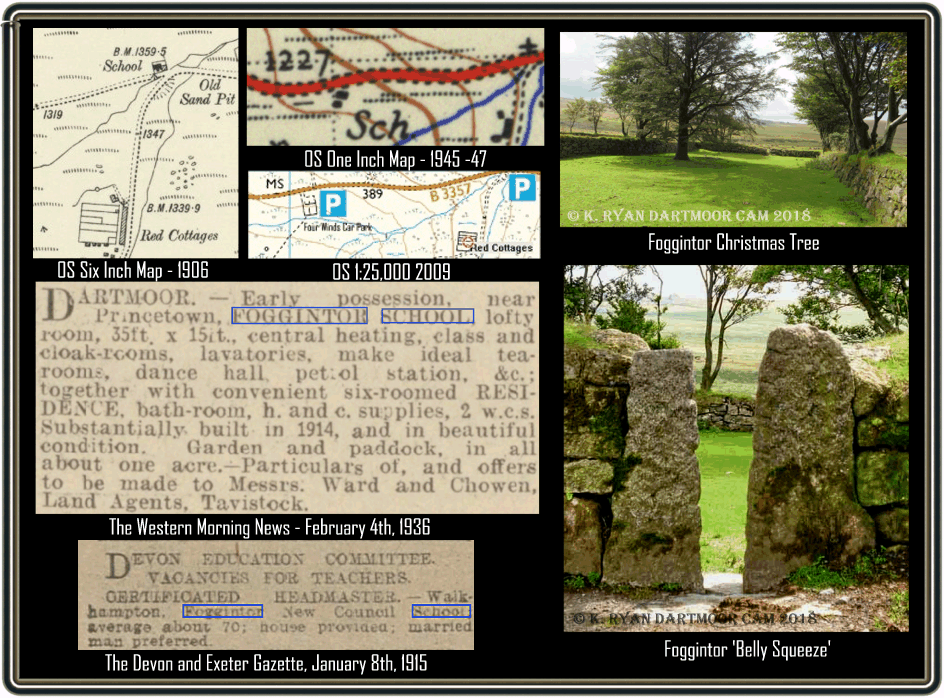
When travelling along the B3357 from Tavistock to Princetown there are several car parks, the largest and most obvious being Pork Hill but probably the one with a hidden secret is that of the enchantingly named ‘Four Winds’, sadly no longer named on many OS maps. The ruined walls that surround the car park tell of a very different past although they give no obvious clue as to what. For instead of today hearing one of the four winds blowing through the surrounding trees you would have heard one hundred years ago the chatter of school children. This car park was once the site of Foggintor School and if you listen carefully you can still hear the sounds of those children chanting their sums, or at least some will say that.
During the late 1800s it was claimed that there were 60 children in the Foggintor area who were not receiving any education. It was proposed that the Rundlestone Mission Hall (situated some 700 metres east of Four Winds) be used temporarily for this purpose at a rent of £5 a year.The only stipulation being that no more than 70 children should attend the school. A Miss Thorne was appointed as headmistress and the new school opened on the 17th of August 1896. The new school admitted children from the nearby Red Cottages, Rundlestone, Merrivale and many of the outlying farms. When the terms of the temporary trust deed had expired it was decided to close the school. However thanks to various donations and subscriptions the school managed to reopen with the luxury of a new playground, garden and yard. The was achieved by reclaiming and enclosing a quarter of an acre of adjacent land. In 1899 the fortunes of the school came into decline, a storm blew the roof off the offices and an inspectors report noted that poor condition of the desks and that there were by this time over 80 pupils attending the school. By 1903 the pupil numbers had risen to 95 and once again the inspectors were showing concerns about overcrowding and once again the state of the desks. In 1908 it seems the inspectors were still very concerned about the overcrowding and plans for a new school were suggested. The following newspaper report appeared in 1910; “The education committee reported that they had submitted to the finance committee an estimate of £1200 for a new school at Foggintor and £400 for a master’s house, the charity commissioners having decided that the existing buildings must not continue to be used as a public school. Mr. Fleming objected to the expenditure, when £300 or £400 the committee could build a new chapel and take over the present building as a school. – Mr. Windeatt, however, said that could not be done. A special sub-committee had done all they could to avoid the erection of a school, but in vain. – The estimate was approved.” The Western Morning News, December 16th, 1910. The Mission Hall school finally closed on the 27th of September 1912 but as the new school at Foggintor was not ready temporary schools were set up at Merrivale and in the small chapel at Foggintor Quarry.
On the 8th of January 1915 (as can be seen below) an advert appeared in the local press for a headmaster it simply stated; “Certificated Headmaster – average about 70, house provided, married man preferred.” Three months later the new Walkhampton Foggintor School finally opened for business on April 19th 1915 with Mr. F. S. Stoyle as its headmaster along with 55 attending pupils. The buildings were substantially built, having wood block floors with solid fuel central heating. Children entered through the two buildings nearest the road, one for the boys and one for the girls. The entrances to the school came with cloakrooms and toilets, the main building contained two classrooms, one for infants and one for 11 to 14-year-olds. Behind the school building were the separate boys’ and girls’ playground, and a separate residence for Mr F S Stoyle. Most of the pupils brought pasties for their lunch, which were heated on the pipes, or later in a double burner oil stove. Later years saw the arrival of a garden in which the girls could grow flowers and various attempts were made at animal husbandry in the form of a goat, a rabbit, poultry and bees. The water supply had always been an issue as initially it was taken from the nearby stream which was often polluted by cattle and sheep. In order to resolve this a nearby well was dug with little success and in the end a supply was piped underground from a spring at Red Cottages. In 1932 the school must have been suffering a fair amount of wear and tear as the Devon County Education Committee were inviting tenders for external renovations to the school and house. Being situated so close to the open moor had its pros and cons, with the Merrivale Antiquities nearby providing an ideal opportunity for study as did the local fauna and flora. On the down side the fact that livestock were also grazing in the area around the school meant that the garden provided a great temptation for supplementing their regular diet. But access was needed from the school grounds to the open more so this problem was overcome by the installation of a ‘squeeze belly’ which simply was two large granite uprights angled in such a way that humans could pass through but not large animals (see photo below). Another problem with having the local fauna so close appeared in the school’s log when it stated that one boy had during his lunch break been bitten by an adder. Reports note that the headmaster applied his first aid skills by attempting to suck out the poison? The other huge problem was Dartmoor’s winter storms which posed problems either getting to the school or arriving home. It has been said that during some heavy falls of snow the children would be ‘chained’ up in a line with skipping ropes and led home.
The school finally closed down in the July of 1936 when the decline in the quarry industry reduced the number of families in the area and it was reported that only 21 children were attending the school.. The children of Foggintor School were then transferred to Princetown Primary School. It was estimated at the time that the closure would save in the region of £300.00 a year. At the final meeting of the school managers Mr. Stoyle the headmaster was presented with a walnut bureau writing desk on behalf of the managers, parents pupils and friends of the school. Miss Knowling the school monitoress was similarly gifted a travel clock and fountain pen. Adverts soon appeared in the local papers for offers to be made for the purchase of the school as can be seen below. Accordingly the property went into private ownership for several years and there is a suggestion that during WWII the American Army used the building as a workshop? Then after a period of laying vacant it finally deteriorated in a state of dereliction. A report in a local paper on March 2, 1964, said that at a public enquiry the previous year the building was described as a ’grave disfigurement in a stretch of completely open moorland’. In March 1964, it was demolished, taking approximately a month to complete — the rubble of which was used on the construction of the ’new’ section of road at Devil’s Elbow on the Princetown to Yelverton Road.
The memory and stories of the remote school still lives on in former pupils and their families. Eric Green from Princetown was born in 1929 in the Quarry Cottage. When Eric was 5-years-old he attended Foggintor School for 12 months before it was closed, and Eric was in one of the last intake of pupils. Even though his time at the school was short Eric remembers those days with fond memories: ’They were happy days! ’One thing I remember is being told we couldn’t cross the river from the Hill Cottages by the quarry to the school — we had to walk a quarter of a mile to the road and along the road to the school. But to be honest we never paid attention and crossed the river! The school was for the children of the cottages and farms and quarries and we were never bothered about health and safety in those days. ’I remember Mr Stoyle — he was brilliant and never used a cane, we all liked him! When I left school at 14 in Princetown I went to work at Tor Royal Farm — it was the best job I ever had.’ One tale Eric recalls is how a large fir tree, a popular sight for all visitors, came to be almost 80 years ago: ’In the last year of the school’s existence, the quarry men gave a gift to the school — the fir tree — which was planted in the garden. Mr. Stoyles’ version of the tree was that it was donated in 1924 by his parents and after being decorated for use at the school party it was transplanted into the school grounds where it still sits today.
In a book Kath Brewer, Eric’s cousin, recounts stories told by her family of their times at the school: ’The school bell was very prominent on the roof of the main building. My father’s youngest brother went to Foggintor School from 1915 when it opened, but had to be up early in the morning to go to Mis Tor Farm for milk before going to school.’ Not the nicest of walks if the weather was inclement. ’My cousins also went to this school until its closure when they had to transfer to Princetown School — which was founded in 1862.’ After the school was closed Kath said it was left empty for some time and in 1938 the property was was bought by a Dr Adamson, who lived there for a time. When he vacated the property, various plans arose to turn it into a restaurant or petrol station, but nothing materialised.”

Brewer, K. 1997. Railways, Quarries and Cottages of Foggintor. Newton Abbot: Orchard Publications
Stanbrook, M. 1991. Old Dartmoor Schools Remembered. Brixham: Quay Publications.
Tavistock Times and Gazette, Memories of Life at a School in the Heart of Dartmoor. Wednesday 1st October, 2014.
 Legendary Dartmoor The many aspects past and present of Dartmoor
Legendary Dartmoor The many aspects past and present of Dartmoor




Brilliant article, thanks! I’m leading a short walk around the quarries in June and plan to provide a few facts for my friends. We’ll park at Four Winds so this is a great start for the narrative! No doubt I’ll find more useful stuff on your excellent pages.
Very interesting article. Parked there in past but didn’t know the history. Up there tomorrow. Will feel the histiry now. Tgank you
Mr Stoyle was my Great-Great Uncle!